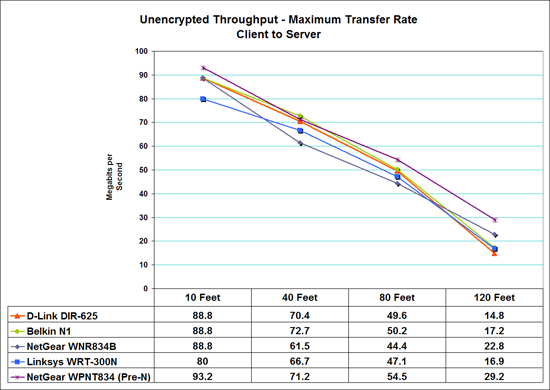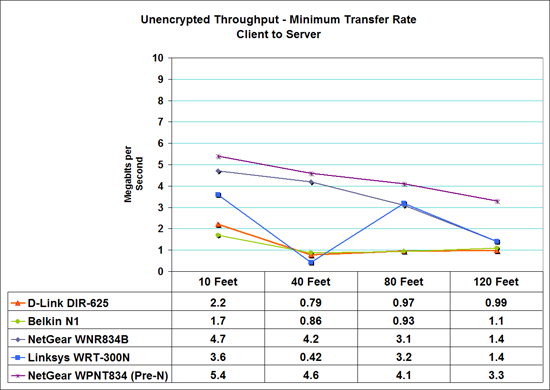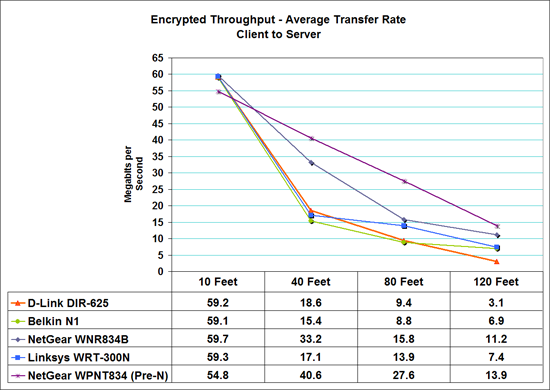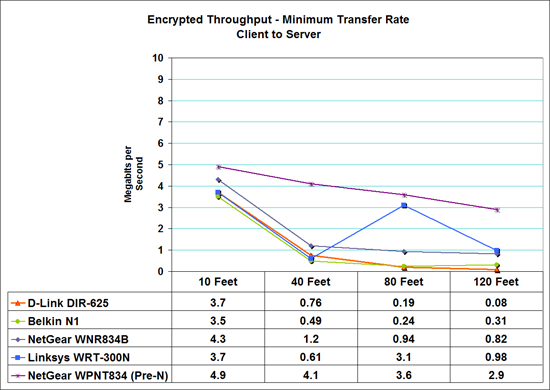D-Link DIR-625: Another Draft N Router comes up short
by Gary Key on September 20, 2006 2:20 AM EST- Posted in
- Networking
Unencrypted Throughput - Client to Server:
Our throughput test compares the performance of our D-Link DIR-625 against the three Draft N routers and the NetGear RangeMax 240 based upon Pre-N MIMO technology. This router features the proprietary third generation Airgo chipset and to date this technology has held the lead in wireless throughput and distance. Belkin has chosen not to support 802.11n or 802.11g only transmission modes so we tested the N1 router with the wireless option set to mixed n/g/b mode. In the test results we are reporting today there are not any 802.11b or 802.11g compliant devices active so the scores should be comparable. In our next series of articles we will look at true mixed mode results along with compatibility between our 802.11n Draft 1.0 devices and other wireless standards.



The NetGear WPNT834 Pre-N router has the highest throughput overall and continues to show a very consistent throughput pattern up to 120 feet. The Belkin N1 and D-Link DIR-625 excel at 40 and 80 feet in maximum throughput compared to our other Draft N routers. At 120 feet the throughput of the Atheros XSpan chipset equipped Belkin and D-Link routers fall off considerably. The NetGear WNR834B still provides the most consistent throughput across the full test spectrum of the Draft N routers.
Encrypted Throughput (WPA2-PSK) - Client to Server:



We spent an inordinate amount of time testing our routers and clients with WPA2-PSK security enabled as the test results were not always consistent or complete. After the final firmware and driver updates we were able to consistently achieve the results shown. However, at first glance you will notice that our encrypted results in the average throughput test are higher than the unencrypted results at 10 feet. We already know that 802.11n Draft 1.0 specifies WPA2 security protocol as the preferred method of encrypted transmission and it appears the hardware is optimized for it at close distances. In order to reach the throughput results we reported your network will have to be free of legacy devices and utilizing the recommended wireless adaptor for the router.
While the 10 foot distance shows very little loss and actually gains for most of the routers we see an issue with the Belkin N1 and D-Link suffering an 18% loss with encryption enabled in the maximum throughput results. This is not surprising as both units are based on the same chipset. On our 40 foot test we see the D-Link DIR-625 experiencing a 53% performance hit in the average throughput numbers and 51% at 80 feet. Our Linksys router after the last firmware update still has a performance issue with WPA2-PSK enabled at the 80 foot range. Once again the NetGear WPNT834 offers the most consistent performance.
Our throughput test compares the performance of our D-Link DIR-625 against the three Draft N routers and the NetGear RangeMax 240 based upon Pre-N MIMO technology. This router features the proprietary third generation Airgo chipset and to date this technology has held the lead in wireless throughput and distance. Belkin has chosen not to support 802.11n or 802.11g only transmission modes so we tested the N1 router with the wireless option set to mixed n/g/b mode. In the test results we are reporting today there are not any 802.11b or 802.11g compliant devices active so the scores should be comparable. In our next series of articles we will look at true mixed mode results along with compatibility between our 802.11n Draft 1.0 devices and other wireless standards.



The NetGear WPNT834 Pre-N router has the highest throughput overall and continues to show a very consistent throughput pattern up to 120 feet. The Belkin N1 and D-Link DIR-625 excel at 40 and 80 feet in maximum throughput compared to our other Draft N routers. At 120 feet the throughput of the Atheros XSpan chipset equipped Belkin and D-Link routers fall off considerably. The NetGear WNR834B still provides the most consistent throughput across the full test spectrum of the Draft N routers.
Encrypted Throughput (WPA2-PSK) - Client to Server:



We spent an inordinate amount of time testing our routers and clients with WPA2-PSK security enabled as the test results were not always consistent or complete. After the final firmware and driver updates we were able to consistently achieve the results shown. However, at first glance you will notice that our encrypted results in the average throughput test are higher than the unencrypted results at 10 feet. We already know that 802.11n Draft 1.0 specifies WPA2 security protocol as the preferred method of encrypted transmission and it appears the hardware is optimized for it at close distances. In order to reach the throughput results we reported your network will have to be free of legacy devices and utilizing the recommended wireless adaptor for the router.
| Unencrypted versus Encrypted Throughput Maximum Mbps - Percentage Difference |
||||
| Client to Server | 10 Feet | 40 Feet | 80 Feet | 120 Feet |
| D-Link DIR-625 | -18.24% | -9.94% | -6.25% | -27.03% |
| Belkin N1 | -18.13% | -15.41% | -6.18% | -16.28% |
| NetGear WNR834B | -9.91% | 8.29% | -14.19% | -6.58% |
| Linksys WRT-300N | -9.25% | -7.80% | -41.61% | -18.34% |
| NetGear WPNT834 (Pre-N) | -9.55% | -14.19% | -11.56% | -13.70% |
| . | ||||
| Unencrypted versus Encrypted Throughput Average Mbps - Percentage Difference |
||||
| Client to Server | 10 Feet | 40 Feet | 80 Feet | 120 Feet |
| D-Link DIR-625 | 4.04% | -53.85% | -51.04% | -58.11% |
| Belkin N1 | 4.23% | -62.80% | -54.64% | -25.00% |
| NetGear WNR834B | 4.92% | -6.74% | -25.82% | -11.81% |
| Linksys WRT-300N | 13.17% | -18.18% | -47.35% | -10.84% |
| NetGear WPNT834 (Pre-N) | -1.79% | -5.36% | -5.48% | -9.15% |
| . | ||||
While the 10 foot distance shows very little loss and actually gains for most of the routers we see an issue with the Belkin N1 and D-Link suffering an 18% loss with encryption enabled in the maximum throughput results. This is not surprising as both units are based on the same chipset. On our 40 foot test we see the D-Link DIR-625 experiencing a 53% performance hit in the average throughput numbers and 51% at 80 feet. Our Linksys router after the last firmware update still has a performance issue with WPA2-PSK enabled at the 80 foot range. Once again the NetGear WPNT834 offers the most consistent performance.










15 Comments
View All Comments
zyren - Wednesday, September 20, 2006 - link
This review is pretty pointless considering the DIR-625 is an old router and the DIR-635 has been the successor of the 625 for a while now (with the atheros chip, if i am correct). I own the 635 and have been very pleased with it. Compared to my old g router, this is so much better. Why didnt they just review the 635?Gary Key - Wednesday, September 20, 2006 - link
We have a review of the DI-635 coming up, however the DI-625 is still for sale and the price point has been moved down to $99 now. Considering the marketing and advertising on this router is still in full swing we thought it was appropriate to review it. Also, in preliminary testing we have found no real difference between the two routers in actual performance. The 120 foot capability of the DI-635 is improved by about 4%, the other ranges are equal or within 1%. :)Chadder007 - Wednesday, September 20, 2006 - link
Im sticking with G for a long time it seems.....N doesn't offer anything extra that I need at home. Videos stream just fine on my G network.Myrandex - Wednesday, September 20, 2006 - link
I have always been a fan of DLink. Their customer support has been nice whenever I have called in, and they actually speak english (not Englishian). Their DGL4300 is an amazing router as well, with integrated Gigabit networking and decent wireless performance (in 802.11g mode with laptop and pocket pc). It looks prety badass as well with the blue LEDs.PAPutzback - Wednesday, September 20, 2006 - link
All I buy is DLINK. My DI-634 works great and my 16 port switch works great. But I won't buy another wireless router until they add gigabit ports. Why do they still limit to 10/100 speeds when even the cheapest MB are coming with gigabit NICsChadder007 - Wednesday, September 20, 2006 - link
Thats what I would like to know.
nullpointerus - Wednesday, September 20, 2006 - link
Have you followed the motherboard benchmarks? A motherboard gigabit NIC consumes tons of CPU time as the bandwidth increases. I assume there are additional cost and design issues for a gigabit router vs. a typical 10/100 Mbps part. My Linksys routers have a hard enough time not burning themselves through the desk just handling very light 10/100 Mbps traffic.yyrkoon - Wednesday, September 20, 2006 - link
They could slap in an Intel GbE processor, especially since the Intel NICs using this processor out perform other NICs of the same class. *shrug*I'm not even going to bother with another wireless router until Wi-Max hits the market personally . . .
mino - Thursday, September 21, 2006 - link
LOL, the problem is how to ROUTE such amount of traffic, not overheating NIC's...yyrkoon - Friday, September 22, 2006 - link
Perhaps, you were talking to the person above me ? In which case you should have replied to him, and not me :)